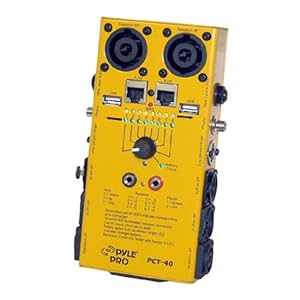
Digital Photography Secretsby David Peterson Click Here! How to
It can be real handy to have one or two further Ethernet cables handy -- when you are rearranging components, or have to hook up a brand-new component. Pre-made cat 5 patch cables are sometimes expensive to buy, however, so it can be economy to learn to make your own. But if you don't do it correctly, your patch cable will be useless.
One of the most common mistakes that many population make when trying to make their own cat 5 patch cables is that they try to use the wrong tools. For example, they may have a crimping cool designed for use with telephone law modular connectors -- they try to use this tool to crimp the connectors for their cat 5 cable wiring -- but it just will work properly, because telephone connectors are a different size from those used on 5 wires.
Cable Tester
Another common mistake is in not purchasing adequate cable. You can generally buy cat 5 patch cable wiring in 1000-foot rolls -- if that will be too much for your wiring project, you can keep the rest of it in storage, in case your installed cable goes bad in the future. Or, you can pass along the extra cabling to a friend or family member so they can do their own home computer wiring.
In increasing to these materials, you will also need a good-quality stripping tool -- don't try to use a pen knife or something like that to strip off the outer insulation from the cat 5 patch cable. When used properly, a stripping tool will strip away the exterior covering, without cutting or nicking the smaller, inside wires -- and it's very important that you don't.
Another very important item to have on hand is a cable tester. This device will allow you to check the integrity of your cable connections, before you positively try to use it with your computer equipment. Many population struggle, trying to figure out what is wrong with their computer network connections, when the problem can be traced to a bad patch cord.
If you look inside of your cat 5 cable, you will see four pairs of smaller wires -- two wires twisted together -- it is very important that you do not untwist these wires any more than is needful in order to expose adequate wiring to attach your connector. The presume for this is that each pair of twisted wires has been designed to work together, to minimize interference with the other sets of wires inside the cable. If you untwist these wires more than necessary, this dampening corollary is lost, and it could influence the operation of your patch cable.
Another area where population get messed up is that they handle cat 5 cable improperly. A common mistake is to staple this cable to the bottom of a wall or on a baseboard. This can crimp or crush the wires inside your cable. Instead, use only manufacturer-recommended supplies to hold your cat 5 cable in place. As well, make sure that you do not lay your cable near any existing wiring -- it may interfere with the signal transmission through the cable.
A final mistake that many population make when constructing their own cat 5 patch cables is not testing the cable once the connectors have been attached. It is all the time a good institution to use your testing device to verify the potential and integrity of your connections before you began using your patch cord. If your testing device indicates there is a problem, cut off one end of the cable and attach a new connector -- then test it again. If there is still a problem with your cat 5 patch cable, flip it over and cut off the other end and attach a new connector there as well. Now test it -- once you get a green Light from your testing equipment, then you can begin putting that patch cable to good use.
manufacture Your Own Cat 5 Patch Cable - Some tasteless Pitfalls and Mistakes
Digital Photography Secrets by David Peterson Click Here!
Tags : USB Battery Charger & Accessories Deals Crawl Space Dehumidifiers

